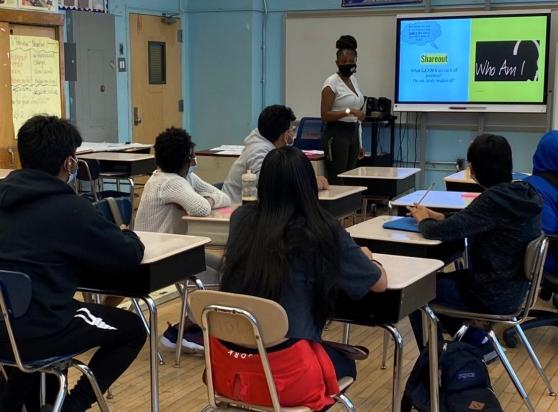Implementing culturally responsive education

Shauna McGee is happy to see her students in person this year instead of "icons on a screen."
“We in the BUILDING!” This is my mantra as I think about being back to brick-and-mortar teaching this school year. I am excited to see actual students’ faces instead of icons on a screen, and I appreciate seeing my colleagues in person as we laugh in the hallway. But now I’m going to say the quiet part out loud: “We can’t go back to normal.”
For a lot of our students — specifically students with varied learning needs, multilingual learners and students in temporary housing — a return to “normalcy” might mean being unseen and devalued in a space that is supposed to nurture and cultivate but is a constant reminder of what they “cannot do.” A “return to normal” risks pushing pedagogy, academic standards and exams without trying to incorporate our students’ identities, lived experiences and perceptions about the world around them.
Rather than just seeing them for what their scores say or what we unconsciously believe about them, we need to make sure that we as teachers are centering student voices and experiences in our curriculum and instruction. To do this, we need to implement culturally responsive education and practices into our learning communities.
I’ve heard some of the objections: “Why? Isn’t this culturally responsive nonsense politically motivated?” “Isn’t it only for Black students?” “I can’t take on anything else. I have to get through the curriculum.”
Let’s debunk these: No, providing our students with mirrors into their experiences and windows into the experiences of others is not political; it’s a moral imperative. No, it’s not only for Black students, it is for all students who feel left out of and disconnected from what they are learning. Culturally responsive education and practices live in our standards and are connected to the Danielson Framework for Teaching, but they do require a shift in our pedagogical strategies and mindset.
So how do we do it? Step one is reflecting, unpacking, unlearning and relearning some of the things we were taught about specific groups, about the best ways to teach and about our roles as educators.
The second step is to conduct an audit of what you are already teaching and using as resources. You can use a curriculum scorecard created by New York University to evaluate your lessons.
Step three is to unpack your data through disaggregation. Look at your data based on gender in your classes. Then look at your data again based on race and on student identification (gen-ed, students with disabilities, gifted and talented). Now ask yourself: What story is being told? How many students was I reaching according to my own data?
The next step is to invest in yourself and deepen your learning through professional literature. “Culturally Responsive Teaching and the Brain,” by Zaretta Hammond, helped me understand how to create independent learners who think critically. Dr. Gholdy Muhammad in “Cultivating Genius” helped me make a clear connection between the standards I had to teach and the experiences of my students. This professional learning allowed for our grade team to take units that had great bones and adapt them to be more inclusive and representative of the young people in front of us.
While we cannot always choose the curriculum we teach, we can adapt our lessons and access points to truly support our students. In remote learning, I witnessed colleagues across my district use culturally responsive teaching to make sure our kids felt safe and loved while still learning. That shift will have the greatest impact on our students.
Shauna McGee is an ELA teacher and a master teacher at Castle Hill MS in the Bronx.